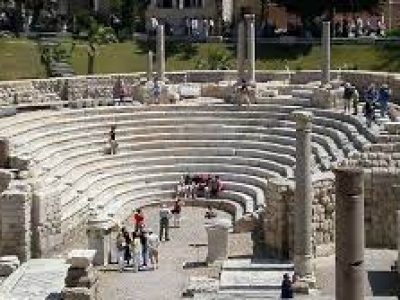Roman amphitheater are theatres – large, circular or oval open-air venues with raised seating – built by the ancient Romans. They were used for events such as gladiator combats, venationes (animal slayings) and executions. About 230 Roman amphitheatres are across the area of the Roman Empire. Early amphitheatres date from the Republican period,though they became more monumental during the Imperial era.
Amphitheatres are distinguished from circuses and hippodromes, which were usually rectangular and built mainly for racing events, and stadia, built for athletics, but several of these terms have at times been used for one and the same venue. The word amphitheatrum means “theatre all around”. Thus, an amphitheatre is different from the traditional semicircular Roman theatres by being circular or oval in shape.
Components of Roman amphitheater
The Roman amphitheatre consists of three main parts: the cavea, the arena, and the vomitorium. The seating area is called the cavea (Latin for “enclosure”). The cavea is formed of concentric rows of stands which are either supported by arches built into the framework of the building, or simply dug out of the hillside or built up using excavated material extracted during the excavation of the fighting area (the arena).
The cavea is traditionally organised in three horizontal sections, corresponding to the social class of the spectators.
Roman amphitheater in Alexandria
The Roman Amphitheater Alexandria is one of the most popular monuments in Alexandria City . Alexandria is the second most important city in Egypt after Cairo . Amphitheaters quite spread during the reign of the Romans. They were in different countries like Greece, Italy, and Turkey. They are pres
ent in many regions around Europe and the Middle East. Roman Amphitheater Alexandria is the only one of its type in Egypt . It was where important meetings like public assemblies and governmental summits take place.The Roman Amphitheater Alexandria featured with its marble audiences section. It is symmetrical with extended wing. In fact, it hosted up 600 spectators. The audience section of the Roman Amphitheater has a diameter of about 33 meters. It consists of 13 rows. They made of European white marble. The uppermost part was a portico which made out of Granite columns. Granite columns brought from Aswan and some of them are still standing until today.
History
The Roman Amphitheater Alexandria neglected during the early Islamic period and onward. In fact, it was until discovered during the middle of the 20th century. It became one of the most marvelous historical sites of the city of Alexandria. The Roman Amphitheater which we see today constructed in the 4th century AC. It was a common feature of the Graeco Roman period. They built to host music ceremonies and poet competitions during the reign of the Romans in Egypt .
El Neweiry was the one who gave the area its recent famous name. The Roman Amphitheater Alexandria indeed is one of the most important Roman architectural achievements in Egypt . It was by mere coincidence in 1960. The workers went to remove a pile of dust and sand in 1960. It was to clear the land and construct a governmental building. They found some solid iron columns while digging into the ground .





Comment (0)